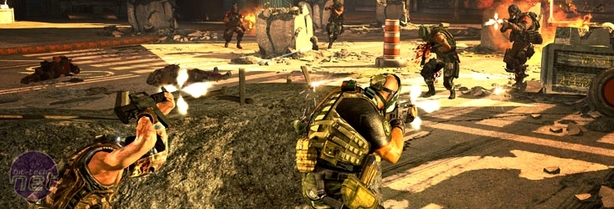
Balancing and Banality
BT: It's a recurring problem or issue, where developers see themselves getting in trouble over what players have done. Like with the Oblivion mods and Hot Coffee and so on. Given that, why did you decide to move the story to a more urban setting?M: Well, the first one was all about the international intrigue and locations and complicated, conspiracy-driven thing. I think with the new game we wanted a story that was a bit more personal and intimate and about developing the characters on that level. A more urban and closed - well, closed is the wrong word, but...defined environment allows you to do that. You can have different types of locations and have things evolve in one spot, instead of always having to move on.
Also, Shanghai is a really cool city. A lot of wicked environments there, which gives us lots of options. There are high rises which are super brand new, business districts, the river that cuts through the city, downtown, the parks, zoos, tenements - all these environments to use and manage. It all came together and so we thought we'd just do it there. It made sense.
BT: You described it earlier as 'lego with guns', but can you tell us a bit more about the weapon customisation system and how it defers from the previous game?
M: Well, in the previous game your customisation was limited to the gun that you had. There was a pool of parts basically and you could put them on to various guns and that's it. That's all you could do. It was self-contained.
What we wanted to do was take that and make it open so that you can really customise all your guns into what you want them to be. Take anything you see on a gun can be take and used. It gives awesome options to the player, not just in terms of freedom of how you play the game, but also in terms of style. Like, my gun has the camo print and the big bayonet and a smaller clip for lightweight combat and it lets people who want it to get a deeper, more fun experience out of it. I think it's really cool.
BT: How difficult do you find it to balance all that, especially in a co-op game? Because if the players wanted to then they could create really advanced tactics to take down every enemy in the game?
M: Well, it's definitely a big challenge when you're building a co-op game that you've got to take into account exactly that; that there's two players who could just go back to back and beat the game that way. You have to manage it through lots of clever little design tricks, but it's also solved through play-testing. We play-test the hell out of this game.
We get everyone we can, gamers like you and I or just people off the street and say, hey, play this. We watch them, then we ask them questions and both steps yield invaluable data to us. The answers they give are one thing, but it's also important to watch what they do and the exploits they find. We find that stuff and we fix it. It's a mix of smart design and then getting play-testers into those levels and seeing how they negotiate them. It's an on-going battle.
BT: How early do you start your playtesting then, because I know that different teams handle it differently?
M: As soon as we have something that's playable - as in you can run it and it won't crash, regardless of how polished it is, then that's where we start. We start there. As per volume and how many people we have at different stages then it can vary and it depends on what we can get, but very early on we ask people to try it out. That's the best way to do it because, like you said before, what players want and what they ask for are two very different things and this is a way to find that out. We watch them play and see what they actually reckon is important.
And that's all we had time for! Army of Two: The 40th Day is out for the Xbox 360, PlayStation 3 and PSP early next year. Until then, drop your thoughts in the forums!

MSI MPG Velox 100R Chassis Review
October 14 2021 | 15:04











Want to comment? Please log in.